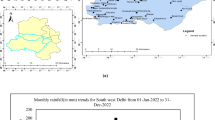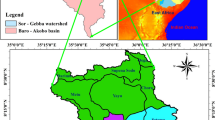Abstract
Use of δ11B provides a solid tool for discriminating hydrogeochemical processes in complex coastal aquifers. Its efficiency increases markedly when it is applied along with other major or minor constituents. Nevertheless, various factors may affect its interpretation: the presence of clays, which favour adsorption and desorption, the influence of wastewaters, and even the presence of geothermalism. The δ11B has been applied to the study of a series of aquifers in south-eastern Spain: Castell de Ferro (Granada), Campo de Dalías, Lower Andarax and Sorbas (Almería), all of which are complex and heterogeneous. The results obtained demonstrate that the concentration of Br, the SO4/Cl and Cl/Br ratios are good indicators of marine intrusion. Inland some negative values of δ11B (−16.7 and −8.1‰) are related to a geothermal influence (34.8 and 51.5°C). The boron solubility is directly related to temperature favours boron mobilization, even from the associated metapelitic deposits. The difference in the boron isotope content in two carbonate units must be caused by the different composition of the carbonate rocks, as well as a long residence time.










Similar content being viewed by others
References
Arad, A., Kafri, U., Halicz, L., & Brenner, I. (1986). Genetic identification of the saline origins of groundwaters in Israel by means of minor elements. Chemical Geology, 54, 251–270.
Arnorsson, S., & Andresdottir, A. (1995). Process controlling the distribution of boron and chlorine in natural waters in Iceland. Geochimica and Cosmochimica Acta, 59, 4125–4146.
Barth, S. (1993). Boron isotope variations in nature: A synthesis. Geologische Rundschau, 82(4), 640–651.
Barth, S. (1998a). Boron isotope geochemistry as a tracer for the evolution of natural aquatic systems. In Arehart & Hulston (Eds.), Water–Rock interaction. Balkema.
Barth, S. (1998b). 11B/10B variations of dissolved boron in a freshwater–seawater mixing plume (Elbe Estuary, North Sea). Marine Chemistry, 62, 1–14.
Barth, S. (2000). Utilisation of boron as a critical parameter in water quality evaluation: implications for thermal and mineral water resources in SW Germany and N Switzerland. Environmental Geology, 40(1–2), 73–89.
Basset, R. L., Buszka, P. M., Davidson, G. R., & Chong-Díaz, D. (1995). Identification of groundwater solute sources using boron isotopic composition. Environmental Science and Technology, 29(12), 2915–2922.
Calaforra, J. M., & Pulido-Bosch, A. (2003). Evolution of the gypsum karst of Sorbas (SE Spain). Geomorphology, 50(1–3), 173–180.
Calvache, M. L., & Pulido-Bosch, A. (1994). Modelling the effects of salt water intrusion dynamics for coastal karstified block connected to a detrital aquifer. Ground Water, 32(5), 767–777.
Custodio, E., & Herrera, C. (2000). Utilización de la relación Cl/Br como trazador hidrogeoquímico en hidrología subterránea. Boletín Geológico y Minero, 111(4), 49–68.
Davis, S. N., Cecil, L. D., Zreda, M., & Moysey, S. (2001). Chlorine-36, bromide and the origin of spring water. Chemical Geology, 179, 3–16.
Duce, R. A., & Hoffman, E. J. (1976). Chemical fractionation at the air–sea interface. Annual Review of Earth and Planetary Sciences, 4, 187–228.
Eisenhut, S., Heumann, K. G., & Vengosh, A. (1996). Determination of boron isotopic variations in aquatic systems with negative thermal ionization mass spectrometry as a tracer for anthropogenic influences. Fresenius Journal of Analytical Chemistry, 354, 903–909.
Gerritse, R., & George, R. J. (1988). The role of soil organic matter in the geochemical cycling of chloride and bromide. Journal of Hydrology, 101, 83–91.
Gregoire, D. C. (1987). Determination of boron isotope ratios in geological materials by inductively coupled plasma mass spectrometry. Analytical Chemistry, 59, 2479–2484.
Hsissou, Y., Mudry, J., Mania, J., Bouchaou, L., & Chauve, P. (1999). Use of the Br/Cl ratio to determine the origin of the salinity of groundwater: An example from the Souss plain (Morocco). Comptes rendus de l’Académie des sciences Paris, 323, série IIa, 381–386.
Kakianha, H., Ossaka, T., Oi, T., Musashi, M., & Nomura, M. (1989). Boron isotopic ratios of some hot springs waters in the Kusat-su-Shirane area, Japan. Geochemical Journal, 21, 133–137.
Kastner, M., Elderfield, H., Martin, J. B., Suess, E., Kvenvolden, K. A., & Garrison, R. E. (1990). Diagenesis and interstitial-water chemistry at the Peruvian continental margin-major constituents and strontium isotopes. In E. Suess, R. von Huene et al., Proc. ODP, Sci. Results, 112: College Station, TX (Ocean Drilling Program), 413–440.
Kiss, E. (1988). Ion-exchange separation and spectrophotometric determination of boron in geological materials. Analytica Chimica Acta, 211, 243–256.
Larsen, D., Swihart, G., & Xiao, Y. (2001). Hydrochemistry and isotope compositions of springs in the Tecopa basin, southeastern California, USA. Chemical Geology, 179, 17–35.
Leenhouts, J. M., Basset, R. L., & Maddock, T. (1998). Utilisation of intrinsic boron isotopes as co-migrating tracers for identifying potential nitrate contamination sources. Ground Water, 36(2), 240–250.
Molina, L., Sánchez-Martos, F., Pulido-Bosch, A., & Vallejos, A. (2003). Origin of boron from a complex aquifer in Southeast of Spain. Environmental Geology, 44, 301–307.
Molina, L., Vallejos, A., Pulido-Bosch, A., & Sánchez-Martos, F. (2002). Water temperature and conductivity variability as indicators of groundwater behavior in complex systems in the south-east of Spain. Hydrological Processes, 16(17), 3365–3378.
Morell, I., Medina, J., Pulido-Bosch, A., & Fernández-Rubio, R. (1986). The use of bromide and strontium as indicators of marine intrusion in the aquifer of Oropesa-Torreblanca. Castellón. Spain. Proc. 9th. Salt Water Intrusion Meeting, Delft, Denmark 61–72.
Murray, K. S. (1996). Hydrology and geochemistry of thermal waters in the Upper Napa Valley, California. Ground Water, 34(6), 1115–1124.
Oi, T., Ikeda, K., Nakano, M., Ossaka, T., & Ossaka, J. (1996). Boron isotope geochemistry of hot springs waters in Ibusuki and adjacent areas, Kagoshima, Japan. Geochemical Journal, 30, 273–287.
Oi, T., & Kakianha, H. (1993). Influence of seawater on boron isotopic compositions of hot springs waters in Japan. Seventh Simposium on Salt, I, 159–164.
Pennisi, M., Bianchini, G., Muti, A., Kloppmann, W., & Gonfiantini, R. (2006a). Behaviour of boron and strontium isotopes in groundwater–aquifer interactions in the Cornia Plain (Tuscany, Italy). Applied Geochemistry, 21, 1169–1183.
Pennisi, M., Gonfiantini, R., Grassi, S., & Squarci, P. (2006b). The utilization of boron and strontium isotopes for the assessment of boron contamination of the Cecina River alluvial aquifer (central-western Tuscany, Italy). Applied Geochemistry, 21, 643–655.
Pennisi, M., Leeman, W. P., Tonarini, S. Pennisi, A., & Nabelek, P. (2000). Boron, Sr, O, and H isotope geochemistry of groundwaters from Mt. Etna (Sicily): Hydrologic implications. Geochimica and Cosmochimica Acta, 64(6), 961–974.
Plummer, L. N., Wigley, T., & Parkhurst, D. (1978). The kinetics of calcite disolution in CO2 water systems at 5 to 60 C and 0.0 to 1.0 atm CO2. American Journal of Sciences, 278, 179–216.
Pulido-Bosch, A., Bensi, S., Molina, L., Vallejos, A., Calaforra, J. M., & Pulido-Leboeuf, P. (2000). Nitrates as indicators of aquifer interconnection. Application to the Campo de Dalías (SE-Spain). Environmental Geology, 39(7), 791–799.
Pulido-Bosch, A., Calaforra, J. M., Pulido-Leboeuf, P., & Torres-Garci’a, S. (2004). Impact of quarrying gypsum in a semidesert karstic area (Sorbas, SE Spain). Environmental Geology, 46(5), 583–590.
Pulido-Bosch, A., Navarrete, F., Molina, L., & Martínez-Vidal, J. L. (1991). Quantity and quality of groundwater in the Campo de Dalias (Almería, SE Spain). Water Science and Technology, 24(11), 87–96.
Pulido-Leboeuf, P. (2004). Seawater intrusion and associated processes in a small coastal complex aquifer (Castell de Ferro, Spain). Applied Geochemistry, 19, 1517–1527.
Pulido-Leboeuf, P., Pulido-Bosch, A., Calvache, M. L., Vallejos, A., & Andreu, J. M. (2003). Strontium and \( {{\text{SO}}^{{2 - }}_{4} } \mathord{\left/ {\vphantom {{{\text{SO}}^{{2 - }}_{4} } {{\text{Cl}}^{ - } }}} \right. \kern-\nulldelimiterspace} {{\text{Cl}}^{ - } } \) and Mg2+/Ca2+ ratios as tracers for the evolution of seawater into coastal aquifers. The example of Castell de Ferro Aquifer (SE Spain). Comptes Rendus Geoscience, 335, 1039–1048.
Richter, B. C., & Kreitler, C. W. (1993). Geochemical techniques for identifying sources of groundwater salinization. New York: CRC press 258 p.
Sanders, L. L. (1991). Geochemistry of formation waters from the Lower Silurian Clinton formation (Albien, Sandstone), Eastern Ohio. The American Association of Petroleum Geologists Bulletin, 75, 1593–1608.
Sánchez-Martos, F. (1997). Hydrogeochemical study of Lower Andarax (Almería). Doctoral Thesis (in Spanish). University of Granada. 290 p.
Sánchez-Martos, F., & Pulido-Bosch, A. (1999). Boron and the origin of salinization in an aquifer in southeast Spain. Comptes rendus de l’Académie des sciences Paris, 328, 751–757.
Sánchez-Martos, F., Pulido Bosch, A., Molina Sánchez, L., & Vallejos Izquierdo, A. (2002). Identification of the origin of salinization in groundwater using minor ions (Lower Andarax, southeast Spain). The Science of the Total Environment, 297, 43–58.
Ulhman, K. (1991). The geochemistry of boron in a landfill monitoring program. Ground Water Monitoring & Remediation, 11(4), 139–143.
Vallejos, A., Pulido-Bosch, A., Martín-Rosales, W., & Calvache, M. L. (1997). Contribution of environmental isotopes to the knowledge of complex hydrologic systems. A case study: Sierra de Gador (SE Spain). Earth Surface Processes and Landforms, 22, 1157–1168.
Vengosh, A., Chivas, A. R., McCulloch, M., Starinsky, A., & Kolodny, Y. (1991a). Boron isotope geochemistry of Australian salt lakes. Geochimica et Cosmochimica Acta, 55, 2591–2606.
Vengosh, A., Chivas, A. R., Starinsky, A., Kolodny, Y., Baozhen, Z., & Pengxi, Z. (1995). Chemical and boron isotope compositions of non-marine brines from the Qaidam Basin, Qinghai, China. Chemical Geology, 120, 135–154.
Vengosh, A., De Lange, G. J., & Starinshy, A. (1998). Boron isotope and geochemical evidence of Urania and Bannock brines at the eastern Mediterranean: Effect of water–rock interactions. Geochimica et Cosmochimica Acta, 62, 3221–3228.
Vengosh, A., Helvaci, C., & Karamanderesi, I. H. (2002). Geochemical constraints for the origin of thermal waters from western Turkey. Applied Geochemistry, 17, 163–183.
Vengosh, A., Heumann, K. G., Juraske, S., & Kasher, R. (1994a). Boron isotope application for tracing sources of contamination in groundwater. Environmental Science & Technology, 28(11), 1968–1974.
Vengosh, A., Spivack, A. J., Artzi, Y., & Ayalon, A. (1999). Geochemical of boron, strontium and oxygen isotopic constraints on the origin of the salinity in groundwater from the Mediterranean coast of Israel. Water Resources Research, 35(6), 1877–1894.
Vengosh, A., Starinsdy, A., Kolodny, Y., & Chivas, A. R. (1991b). Boron isotope geochemistry as a tracer for the evolution of brines and associated hot springs from the Dead Sea, Israel. Geochimica et Cosmochimica Acta, 55, 1689–1695.
Vengosh, A., Starinsky, A., Kolodny, Y., & Chivas, A. R. (1994b). Boron isotope geochemistry of thermal springs from the northern Rift Valley, Israel. Journal of Hydrology, 162, 155–169.
Williams, L., Hervig, R., Wieser, M. E., & Hutcheon, I. (2001). The influence of organic matter on the boron isotope geochemistry of the gulf coast sedimentary basin, USA. Chemical Geology, 174, 445–461.
Acknowledgements
This article was written within the framework of project HID99-0597-CO2, financed by the Spanish CICYT Interministerial Commission of Science and Technology.
Author information
Authors and Affiliations
Corresponding author
Rights and permissions
About this article
Cite this article
Morell, I., Pulido-Bosch, A., Sánchez-Martos, F. et al. Characterization of the Salinisation Processes in Aquifers Using Boron Isotopes; Application to South-Eastern Spain. Water Air Soil Pollut 187, 65–80 (2008). https://doi.org/10.1007/s11270-007-9497-7
Received:
Accepted:
Published:
Issue Date:
DOI: https://doi.org/10.1007/s11270-007-9497-7




